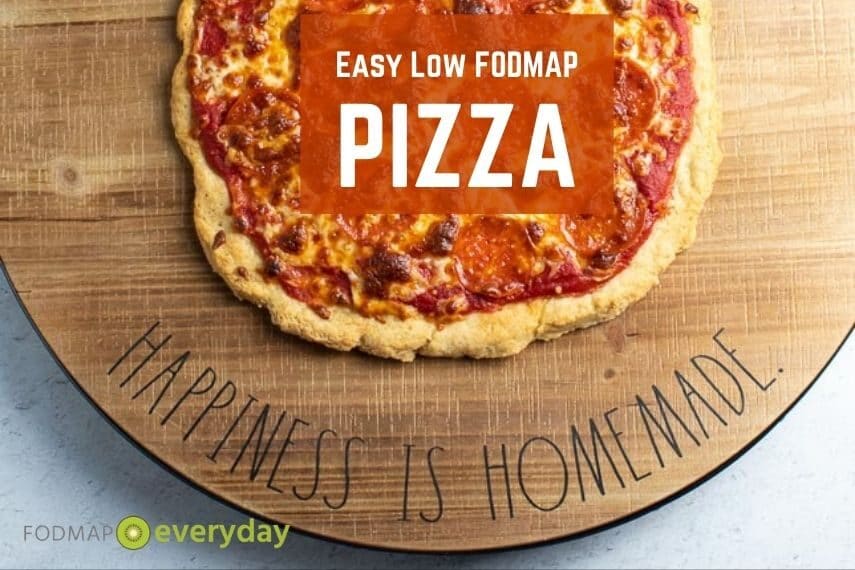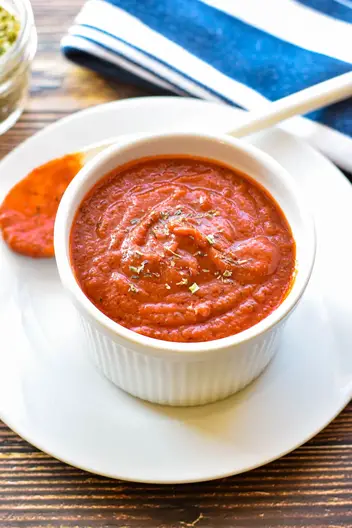Are you looking for a low-FODMAP pizza sauce recipe? Try this easy and delicious homemade tomato sauce made with tomato purée, garlic-infused olive oil, basil, thyme, salt, pepper, and a pinch of paprika.
It’s a perfect option for those following a low FODMAP diet and looking to enjoy a tasty pizza without any digestive discomfort. Say goodbye to store-bought sauces filled with high FODMAP ingredients, and hello to a flavorful homemade pizza sauce that’s safe and delicious to eat.
Follow this recipe to create a low FODMAP pizza sauce that will enhance the taste of your favorite pizza toppings.
The Importance Of A Low Fodmap Pizza Sauce In A Health-conscious Diet
Looking to maintain a health-conscious diet? Incorporating a low Fodmap pizza sauce is essential. You’ll love this easy-to-make recipe for a delicious, digestive-friendly option.
Understanding The Concept Of A Low Fodmap Diet
The first step in understanding the importance of a low Fodmap pizza sauce in a health-conscious diet is to grasp the concept of a low Fodmap diet. The FODMAPs, or fermentable oligosaccharides, disaccharides, monosaccharides, and polyols, cause digestive problems in some individuals.
People who follow a low Fodmap diet avoid foods high in these types of carbohydrates, including fruits, vegetables, grains, and dairy products. By restricting the intake of FODMAPs, they aim to reduce symptoms such as bloating, gas, and stomach pain.
The Impact Of Fodmaps On Digestive Health
FODMAPs can significantly impact digestive health, especially for those with irritable bowel syndrome (IBS) or other digestive disorders. These carbohydrates are not easily absorbed in the small intestine and can reach the large intestine, fermented by gut bacteria.
- This fermentation process can lead to gas production, causing bloating and discomfort.
- In some individuals, FODMAPs can also draw water into the digestive tract, resulting in diarrhea or loose stools.
- The consumption of high FODMAP foods can trigger symptoms and exacerbate digestive issues, making it crucial for those affected to reduce their intake of these carbohydrates.
The Role Of Pizza Sauce In A Low Fodmap Diet
Now, let’s discuss the role of pizza sauce in a low Fodmap diet. Traditional pizza sauces often contain ingredients such as garlic and onions, which are high in FODMAPs. These ingredients can be problematic for individuals following a low Fodmap diet.
Avoiding pizza altogether might seem like the only option, but fear not! You can still enjoy a delicious pizza while sticking to your low Fodmap diet by making a homemade low Fodmap pizza sauce.
By using alternative ingredients and following a low Fodmap pizza sauce recipe, you can create a sauce that satisfies your taste buds and promotes digestive wellness.
Low Fodmap pizza sauce typically includes ingredients such as tomato paste, olive oil, herbs, and spices. These ingredients are common in FODMAPs and can flavor your pizza without causing digestive distress.
By making your own low Fodmap pizza sauce, you can customize the flavors to your liking, ensuring a memorable and enjoyable pizza experience. Home-cooked meals are often healthier and more nutritious than store-bought alternatives.
So, don’t let your low Fodmap diet restrict you from enjoying pizza. You can indulge in this popular dish with a homemade low Fodmap pizza sauce while keeping your digestive health in check.
Choosing The Right Ingredients For A Low Fodmap Pizza Sauce
Choosing the right ingredients is vital when creating a delicious yet low Fodmap pizza sauce. Traditional pizza sauces often contain high Fodmap ingredients such as garlic and onion, which can trigger digestive discomfort for those with sensitive stomachs. But fret not because, with some simple substitutions and the right combination of ingredients, you can enjoy a flavorful low Fodmap pizza sauce without compromising on taste.
Identifying High Fodmap Ingredients In Traditional Pizza Sauces
It’s essential to identify and avoid high Fodmap ingredients commonly found in traditional pizza sauces to create a low Fodmap pizza sauce. These ingredients can include:
- Garlic
- Onion
- Wheat-based thickeners
- High fructose corn syrup
- Added sugars
By avoiding these ingredients, you can ensure your pizza sauce is low in Fodmaps and gentle on digestion.
Substituting High Fodmap Ingredients With Low Fodmap Alternatives
Now that you’ve identified the high Fodmap ingredients to avoid, it’s time to find suitable low Fodmap alternatives. Here are some substitutions you can make:
| High Fodmap Ingredient | Low Fodmap Alternative |
|---|---|
| Garlic | Garlic-infused olive oil |
| Onion | Scallions (green parts only) |
| Wheat-based thickeners | Gluten-free flour or cornstarch |
| High fructose corn syrup | Maple syrup or brown rice syrup |
| Added sugars | Naturally sweet vegetables like carrots or red bell peppers |
By using these low Fodmap alternatives, you can still enjoy the flavors and textures that traditional pizza sauces offer, all while keeping your digestive system happy.
Key Ingredients For A Flavorful Yet Low Fodmap Pizza Sauce
Now that you know which ingredients to avoid and how to make suitable substitutions, let’s take a look at the key elements that will give your low Fodmap pizza sauce a delicious flavor:
- Canned tomato sauce or pureed tomatoes
- Oregano
- Basil
- Salt
- Pepper
- Garlic-infused olive oil
- Scallions (green parts only)
Combining these ingredients in the right proportions allows you to create a flavorful yet low Fodmap pizza sauce that will satisfy your taste buds and keep your tummy happy.
So, the next time you’re craving pizza but want to stick to a low Fodmap diet, remember to choose the right ingredients for your pizza sauce. By identifying high Fodmap ingredients, substituting them with low Fodmap alternatives, and including critical components for flavor, you can create a delicious low Fodmap pizza that is satisfying and gentle on your stomach.
Step-by-step Instructions For Preparing A Low Fodmap Pizza Sauce
Are you following a low Fodmap diet but craving pizza? Don’t worry; we’ve got you covered with this easy and delicious low Fodmap pizza sauce recipe. You can create a flavorful sauce that follows the standard Fodmap guidelines with just a few simple steps. Let’s dive into the step-by-step instructions for preparing this mouthwatering sauce.
Gathering The Necessary Ingredients And Equipment
Before you start making the low Fodmap pizza sauce, make sure you gather all the necessary ingredients and equipment. Here’s what you’ll need:
- Garlic-infused olive oil
- Canned whole peeled tomatoes
- Tomato paste
- Olive oil
- Celery
- Italian seasoning
- Salt
- Pepper
In terms of equipment, you’ll need a saucepan, a blender or food processor, and a wooden spoon for stirring.
Preparing The Tomatoes For The Sauce
Preparing the tomatoes is the first step in making the low Fodmap pizza sauce. To do this, follow these instructions:
- Heat the garlic-infused olive oil in a saucepan over medium heat.
- Add the canned whole peeled tomatoes to the saucepan and break them apart using a wooden spoon.
- Simmer the tomatoes for about 15 minutes until they break down and thicken.
Adding The Other Ingredients And Seasoning To Enhance Flavor
Once the tomatoes have cooked down, it’s time to add the remaining ingredients and seasoning. Here’s how to do it:
- Add the tomato paste, olive oil, celery, Italian seasoning, salt, and pepper to the saucepan.
- Stir well to combine all the ingredients, and let the sauce simmer for 10 minutes.
Simmering And Blending The Sauce To Perfection
The final step in preparing the low Fodmap pizza sauce is to simmer and blend it to perfection. Follow these steps:
- Reduce the heat to low and let the sauce simmer for another 10 minutes to allow the flavors to meld together.
- Take the sauce off the stove and let it cool
- to room temperature.
- Put the sauce in a blender or food processor and whirl it around until it’s completely smooth.
There you have it – a delicious low Fodmap pizza sauce ready to be spread on your favorite pizza crust. Enjoy!
Tips And Tricks For Customizing Your Low Fodmap Pizza Sauce
Customizing your low Fodmap pizza sauce has never been easier with these helpful tips and tricks. From experimenting with different flavors to exploring alternative sauce options, you can create a delicious and digestion-friendly pizza sauce that suits your dietary needs.
Incorporating Additional Herbs And Spices For Added Flavor
Adding herbs and spices is one of the easiest ways to customize your low Fodmap pizza sauce. Not only will this add depth and complexity to your sauce, but it will also enhance the overall taste of your pizza. There are several low Fodmap herbs and spices that you can experiment with, such as:
- Basil
- Oregano
- Thyme
- Rosemary
- Parsley
- Garlic-infused olive oil (a great way to add garlic flavor without the high Fodmap content)
Try adding a combination of these herbs and spices to your sauce and adjust the quantities according to your taste preferences. Remember, starting with a small amount is always better, and gradually increasing if needed.
Adjusting The Consistency Of The Sauce To Personal Preference
The consistency of the sauce is another aspect you can customize. Some people like their pizza sauce to be thick and chunky, while others prefer a smoother and thinner consistency. Here are a few tips to help you achieve the desired consistency:
- If you prefer a thicker sauce, you can simmer it longer to evaporate more liquid and thicken the consistency.
- You can blend the sauce using a food processor or immersion blender to achieve a smoother texture.
- If your sauce is too thick and you want to thin it out, add a small amount of low Fodmap broth or water.
Adjust the consistency gradually, adding small amounts of liquid to avoid making the sauce too watery or thin.
Experimenting With Alternative Low Fodmap Ingredients For Unique Variations
For those looking to create unique variations of low Fodmap pizza sauce, experimenting with alternative ingredients can be a fun and exciting way to add variety to your pizzas. Here are some common Fodmap ingredients you can try:
| Ingredient | Usage |
|---|---|
| Basil pesto | Spread it on the pizza crust before adding the sauce |
| Béchamel sauce | Use it as a base sauce or mix it with the tomato sauce |
| BBQ sauce | For a smokier flavor, substitute tomato sauce with low Fodmap BBQ sauce |
Feel free to get creative and try different combinations of these ingredients to create your own low Fodmap pizza sauce. Just check the ingredients for Fodmap content and adjust the quantities according to your taste.
Serving And Storing Your Homemade Low Fodmap Pizza Sauce
Serving and storing your homemade low-FODMAP pizza sauce is easy. Use it as a delicious topping for your low FODMAP pizzas, and keep any remaining sauce in an airtight container in the refrigerator for up to one week.
Pairing The Sauce With Gluten-free Or Low Fodmap Pizza Crusts
The choice of pizza crust is crucial When enjoying a delicious pizza while following a low Fodmap or gluten-free diet. You want to ensure your crust is free from any ingredients that could trigger digestive discomfort. Luckily, plenty of options are available that pair perfectly with our homemade low Fodmap pizza sauce.
For those on a gluten-free diet, you can opt for a gluten-free pizza crust made from ingredients such as rice flour, almond flour, or even cauliflower. These crusts are readily available in most grocery stores or easily made at home with simple ingredients.
If you are explicitly following a low Fodmap diet, several low Fodmap pizza crust options are also available. These crusts are made with ingredients that are low in Fodmaps, ensuring that you can enjoy your pizza without worrying about triggering any digestive issues. Some popular low Fodmap pizza crust options include spelled flour, sourdough, or gluten-free crusts made with tapioca and brown rice flour.
Pairing your homemade low Fodmap pizza sauce with a suitable crust ensures that every bite of your pizza is delicious and gentle on your stomach.
Properly Storing Leftover Sauce For Future Use
You may find some leftovers after preparing your homemade low Fodmap pizza sauce. Properly storing the dressing will help maintain its freshness and flavor for future use.
To begin, allow the sauce to cool down completely before storing. Condensation, which could alter the consistency of the sauce, will be avoided this way. Once cooled, transfer the sauce to an airtight container or glass jar, ensuring it is tightly sealed.
You can store the sauce in the refrigerator for up to five days, or if you prefer to keep it for a more extended period, it can be frozen. To freeze the sauce, pour it into a freezer-safe container, leaving room for expansion. Seal the container tightly; it can be stored in the freezer for up to three months.
You can defrost the sauce in the microwave or let it sit out at room temperature overnight before using it. Always remember to stir it before using it to ensure the flavors are well blended.
Creative Ways To Use Leftover Pizza Sauce In Other Dishes
Leftover pizza sauce doesn’t have to be limited to just pizza. Plenty of creative ways to give it a new life in other dishes, adding a burst of flavor to your meals. Here are a few ideas to get you started:
1. Pasta Sauce: Use your leftover pizza sauce as a base for a quick and easy pasta sauce. Cook your favorite pasta, then toss it with the pizza sauce and additional toppings or vegetables.
2. Dipping Sauce: Pizza sauce is a fantastic appetizer dipping sauce. Serve it with mozzarella sticks, breadsticks, or chicken nuggets for a flavorful twist.
3. Baked Eggs: Spread a layer of pizza sauce on a baking dish, then crack eggs into the sauce. Bake in the oven until the eggs are set to your liking. This makes for a tasty and filling breakfast or brunch option.
4. Meatball Subs: Warm up your leftover pizza sauce and use it as a topping for delicious meatball subs. Heat pre-cooked meatballs in sub rolls, and drizzle the sauce over them. Top with cheese and bake in the oven until melted and golden.
5. Stuffed Peppers: Cut the tops off bell peppers and remove the seeds. Fill each pepper with cooked rice, ground meat, and pizza sauce. Bake until the peppers are soft, and the filling is thoroughly cooked.
These are just a few creative ways to utilize your leftover pizza sauce. Feel free to experiment and let your culinary imagination run wild! With creativity, you can transform your leftover sauce into a versatile and flavorful ingredient in various dishes.

Credit: www.fodmapeveryday.com
Conclusion
Creating a delicious low-FODMAP pizza sauce doesn’t have to be a challenge. By using simple and flavorful ingredients like tomato paste, olive oil, and herbs, you can enjoy a tasty pizza without the worry of triggering your digestion. Whether following a low FODMAP diet or looking for a healthier alternative, this recipe will satisfy your pizza cravings.
Give it a try and elevate your pizza game to a new level of FODMAP-friendly deliciousness.

As the author of the “Ultimate Pizza Guide: Recipes, Tips & Secrets Revealed,” I’m dedicated to sharing my love for pizza and empowering others to create delicious homemade pizzas with ease. Join me on a journey to uncover the secrets to perfecting your pizza game!



